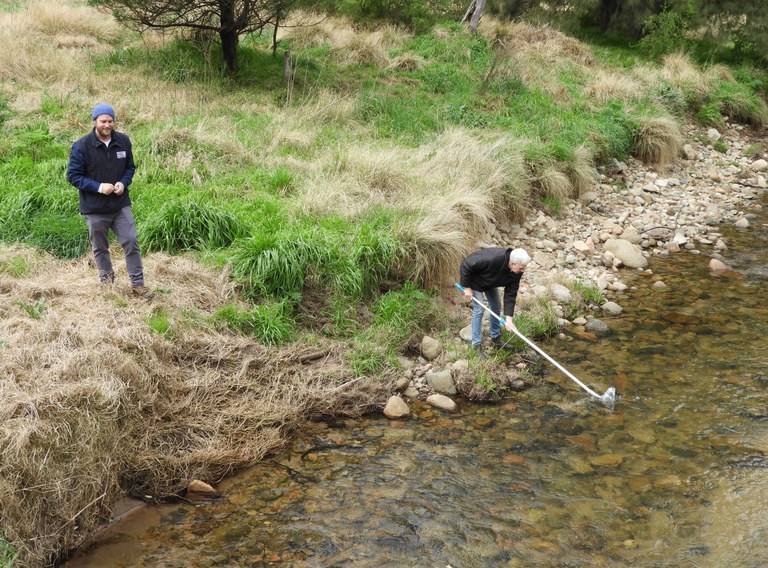
Rivers of Carbon and Waterwatch pay a visit to Araluen Creek
On Saturday 27 August Upper Deua Catchment Landcare (UDCL) hosted the fourth workshop in its Araluen Creek Restoration Project series. Twenty-five people gathered at the Araluen Campground to hear from presenters Lori Gould and Jed Pearson.
Lori is the on-ground Program Manager for Rivers of Carbon. This initiative promotes rivers of life by working with landholders to protect and restore rivers so the resident animals can thrive. Jed is the Waterwatch Coordinator at Molonglo Conservation Group, primarily working in the upper Murrumbidgee catchment area. Together they gave a comprehensive overview of looking after our creeks and assessing water health on the banks of the Araluen Creek.
Lori began the day by stating “everything in the catchment ends up in the creek”, whether it be runoff, sediment, effluent, heavy metals etc. “We’ve created a landscape full of drains… shedding and channeling water at a great rate… whatever we can do to mess it up and slow it down is important”. By “mess it up” Lori referred to ways to add complexity and habitat back to the banks by encouraging vegetation and deposits of woody debris.
She then showed us the Rivers of Carbon Stream Condition Checklist - an easy-to-use guide they’ve developed for assessing the health of a waterway you may want to look after.
If you are thinking about intervening in your creek, Lori’s advice is to think about how it could impact or improve biodiversity. For example, removing all the weeds from a waterway can have an adverse effect. The roots could be stabilizing the banks, the canopy shading the water and keeping it cool, while also providing refuge and habitat for birds. Another tip for best investment of time and effort is to start working in flatter areas. Waterways on steep gradients are high energy, harder to access and can be more expensive to manage and maintain.
Unfortunately, each riparian site is different and generally a one-size-fits-all approach doesn’t work. However, Lori did conclude by saying “95% of waterway issues can be fixed by fencing, excluding livestock and thereby encouraging ground cover”.
After morning tea, Jed stepped the group through all the tools Waterwatch use to monitor trends in water quality. These included measuring water temperature, pH, dissolved oxygen, electrical conductivity and turbidity.
The water quality results along the creek were good, although Jed was surprised by the high electrical conductivity reading. Electrical conductivity, typically measured in MicroSiemens per centimeter or μS/cm, tells you about the levels of ions or dissolved salts in the water. At 350 μS/cm, the Araluen Creek was considerably higher in salts than the recommended <100 μS/cm. Penny Hayman, Secretary of UDCL, speculated “it might be due to all the landslips upstream of the site, where newly exposed granites can leach minerals into the water”.
Another important indicator Jed mentioned for measuring water quality is the presence of bugs. Of the 15 insect orders typically associated with waterways, most are sensitive to pollution to some degree. Losing a single order can have huge impacts for the riparian food chain. A startling example Jed gave us was that waterways without mayflies don’t appear to be able to support Platypus. Improving water quality and creating plenty of habitat to keep the bugs happy is important for maintaining dietary links.
After the workshop, Upper Deua Catchment Landcare is now inspired to get the tools they need to do regular water quality monitoring at five sites along Araluen Creek. This way they can measure the impact of the major works they are putting in to rehabilitate and revegetate the creek, including fencing off stock, and adding rocks and root balls to curb erosion.
Following this workshop, the next instalment in the Araluen Creek Restoration Project is on Saturday 10 September, 9:30 am - 2:30 pm. Back by popular demand, Daniel Anderson and his team from Apical will be demonstrating how to tackle a range of high-priority weeds along the creek, including Madeira vine and African Lovegrass. You can register your interest at upper.shoalhaven@gmail.com. Alternatively, if you are after more information on riparian management, Rivers of Carbon have great resources on their website www.riversofcarbon.org.au.
Jed Pearson outlines the different tools Waterwatch use to monitor water quality.
Workshop participants have a go at sampling water from the Araluen Creek.




